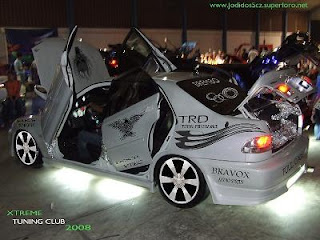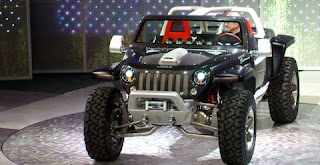Best Truck Modification
Friday, October 1, 2010
Citroen C Metisse Concept Car
Citroen C Metisse Concept Car
TECHNICAL CHARACTERISTICS
• Dimensions
Length: 4,740 mm
Width: 2,000 mm
Height: 1,240 mm
Wheelbase: 3,000 mm
Gross vehicle weight (GVW): 1,400 kg (batteries included)
• Performance and fuel consumption
0 to 400 m: 14.2 seconds
0 to 1,000 m: 25.4 seconds
0 – 100 kph: 6.2 seconds
30 – 60 kph: 1.9 seconds
80 – 120 kph: 4.2 seconds
Top speed: 250 kph
Combined consumption: 6.5 l/100 km
CO2 emissions: 174 g/km
• Diesel hybrid drivetrain
V6 HDi diesel engine developing 150 kW (208 bhp) with a DPFS and 6-speed automatic transmission
Two electric motors in the rear wheels:
- each with torque of 400 Nm
- and developing 15 kW (20 bhp)
ZEV mode (range of 3 km at 30 kph)
• Aerodynamic features
Flat underside
Enlarged air intakes at the front
Two retractable rear airfoils
Rear fixed-fin spoiler
Cd: 0.30
CdA: 0.6 m²
Cl: – 0.1
• Running gear
Hydraulic suspension
Double wishbone suspension on all four wheels
Special Michelin tyres: 255/40/R20
• Main equipment
Fixed-centred controls steering wheel
6-speed gearbox, manual mode controlled by steering-wheel paddles, or fully automatic mode controlled by a selection lever on the central column
Directional headlamps
Electrically adjustable steering wheel and pedal assembly
Aluminium wheels with a central nut
4x4 Concept Car
4x4 Concept Car
A 4x4 concept car from 4x4 manufacturers can give you an idea about the future development of the eventual production vehicle. I try to keep up with new concept 4x4 vehicles and give you an idea about the potential in the design as it relates to off-road capability.
The emphasis is on portraying bold new designs that could prove easy to modify and have convincing hardware.
Nissans Concept Car For Ocean Shooters
Nissans Concept Car For Ocean Shooters
Talk about niche marketing: Nissan's new concept vehicle, the NV200, was specifically designed to be a mobile office for ocean photographers. Loaded up with nautical gear, digital photo processing equipment and remote controls for underwater cameras, the pull-out storage compartment can be customized and filled with other equipment in case you get bored of your millionaire hobby. The NV200 will debut at the Tokyo Motor Show.
Tuesday, September 28, 2010
Car Tuning
There are different equipments that speed enthusiasts can attached to their car’s engine to boost power. One of them is what you call turbochargers. Plainly speaking, turbochargers are pumps that collect and compress air into the cylinder. By compressing the air, it allows more air to fit into the cylinder, creating more power because of the increase in combustibility of air-fuel mixture. There are turbo kits available for different cars that are commonly modified for racing. The kits normally include manifolds, down pipes, intercooler, turbo, waste gate, blow off valve, fittings, and tubings, depending on the car make or model.
You can also get a turbo for your car from among different manufacturers such as HKS, Blitz, Greddy, and Garrett. Each manufacturer has different specifications of their turbos, therefore it is important to know which one fits your engine. Intercoolers usually go with turbos. Intercoolers make the compressed air cooler so that the cylinders can take in more air to increase horsepower.
Turbo boost controllers are used to increase the boost pressure of turbos. You can choose from industry leaders including HKS, Blitz, Greddy, and Turbosmart. They offer turbo boost controllers with different features and specifications. Some even allow you to program boost curves to vehicle speed.
Other turbo accessories include boost gauges and turbo timers. Boost gauges practically allows you to monitor boost levels, while turbo timers keeps your engine running for a specified time, giving the turbo time to cool down. It automatically switches off your engine after the preset time has lapsed.
Superchargers are just basically like turbochargers in function and use. The difference between the two lies in what run the air pumps. Superchargers are belt driven while turbochargers get power from the exhaust gas. It is simpler to install a supercharger than turbocharger because it has fewer parts than the latter. However, turbochargers are still preferred by most boost-hungry drivers due to its market availability. This means that drivers will not have a hard time looking for a turbo that will match with their engine.
Nitrous Oxide Systems (NOS) provides extra oxygen to burn more fuel resulting to increased energy and power. Nitrous Oxide is stored in its liquid form inside a highly pressurized container, but comes out of it in vapor form. It is injected into the engine’s intake valve, breaks down into its basic components of nitrogen and oxygen upon reaching a certain temperature level, producing more oxygen to burn more fuel, resulting in increased horsepower. This is excluding the power gain resulting from the inherent cooling property of nitrous oxide. A power boost of 100 to 300 percent over stock is not impossible with NOS.
What’s good about NOS is that is it versatile. You can use it in one car, take it out and install it in another without hassle. You can use NOS only when you need it; meaning you can use your car in its normal state saving you some gas money.
You can also get a turbo for your car from among different manufacturers such as HKS, Blitz, Greddy, and Garrett. Each manufacturer has different specifications of their turbos, therefore it is important to know which one fits your engine. Intercoolers usually go with turbos. Intercoolers make the compressed air cooler so that the cylinders can take in more air to increase horsepower.
Turbo boost controllers are used to increase the boost pressure of turbos. You can choose from industry leaders including HKS, Blitz, Greddy, and Turbosmart. They offer turbo boost controllers with different features and specifications. Some even allow you to program boost curves to vehicle speed.
Other turbo accessories include boost gauges and turbo timers. Boost gauges practically allows you to monitor boost levels, while turbo timers keeps your engine running for a specified time, giving the turbo time to cool down. It automatically switches off your engine after the preset time has lapsed.
Superchargers are just basically like turbochargers in function and use. The difference between the two lies in what run the air pumps. Superchargers are belt driven while turbochargers get power from the exhaust gas. It is simpler to install a supercharger than turbocharger because it has fewer parts than the latter. However, turbochargers are still preferred by most boost-hungry drivers due to its market availability. This means that drivers will not have a hard time looking for a turbo that will match with their engine.
Nitrous Oxide Systems (NOS) provides extra oxygen to burn more fuel resulting to increased energy and power. Nitrous Oxide is stored in its liquid form inside a highly pressurized container, but comes out of it in vapor form. It is injected into the engine’s intake valve, breaks down into its basic components of nitrogen and oxygen upon reaching a certain temperature level, producing more oxygen to burn more fuel, resulting in increased horsepower. This is excluding the power gain resulting from the inherent cooling property of nitrous oxide. A power boost of 100 to 300 percent over stock is not impossible with NOS.
What’s good about NOS is that is it versatile. You can use it in one car, take it out and install it in another without hassle. You can use NOS only when you need it; meaning you can use your car in its normal state saving you some gas money.
Subscribe to:
Comments (Atom)








